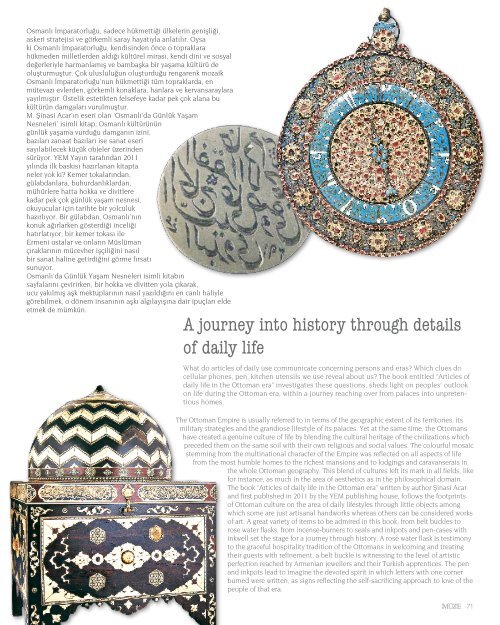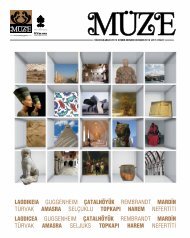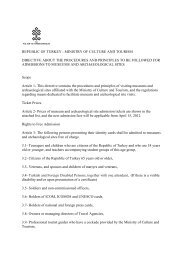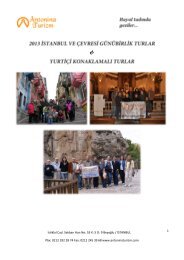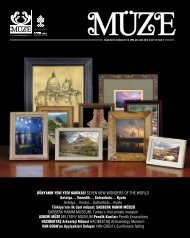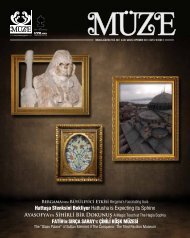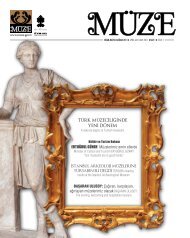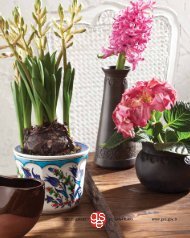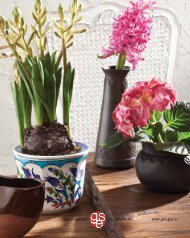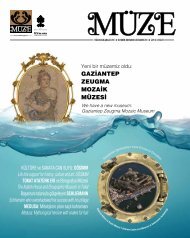ANTÄ°K DÃNYANIN KEHANET MERKEZÄ°: DIDYMA Zamanın ... - MÃZE
ANTÄ°K DÃNYANIN KEHANET MERKEZÄ°: DIDYMA Zamanın ... - MÃZE
ANTÄ°K DÃNYANIN KEHANET MERKEZÄ°: DIDYMA Zamanın ... - MÃZE
Create successful ePaper yourself
Turn your PDF publications into a flip-book with our unique Google optimized e-Paper software.
Osmanlı İmparatorluğu, sadece hükmettiği ülkelerin genişliği,askeri stratejisi ve görkemli saray hayatıyla anlatılır. Oysaki Osmanlı İmparatorluğu, kendisinden önce o topraklarahükmeden milletlerden aldığı kültürel mirası, kendi dini ve sosyaldeğerleriyle harmanlamış ve bambaşka bir yaşama kültürü deoluşturmuştur. Çok ulusluluğun oluşturduğu rengarenk mozaikOsmanlı İmparatorluğu’nun hükmettiği tüm topraklarda, enmütevazı evlerden, görkemli konaklara, hanlara ve kervansaraylarayayılmıştır. Üstelik estetikten felsefeye kadar pek çok alana bukültürün damgaları vurulmuştur.M. Şinasi Acar’ın eseri olan ‘Osmanlı’da Günlük YaşamNesneleri’ isimli kitap, Osmanlı kültürününgünlük yaşama vurduğu damganın izini,bazıları zanaat bazıları ise sanat eserisayılabilecek küçük objeler üzerindensürüyor. YEM Yayın tarafından 2011yılında ilk baskısı hazırlanan kitaptaneler yok ki? Kemer tokalarından,gülabdanlara, buhurdanlıklardan,mühürlere hatta hokka ve divitlerekadar pek çok günlük yaşam nesnesi,okuyucular için tarihte bir yolculukhazırlıyor. Bir gülabdan, Osmanlı’nınkonuk ağırlarken gösterdiği inceliğihatırlatıyor, bir kemer tokası ileErmeni ustalar ve onların Müslümançıraklarının mücevher işçiliğini nasılbir sanat haline getirdiğini görme fırsatısunuyor.Osmanlı’da Günlük Yaşam Nesneleri isimli kitabınsayfalarını çevirirken, bir hokka ve divitten yola çıkarak,ucu yakılmış aşk mektuplarının nasıl yazıldığını en canlı haliylegörebilmek, o dönem insanının aşkı algılayışına dair ipuçları eldeetmek de mümkün.A journey into history through detailsof daily lifeWhat do articles of daily use communicate concerning persons and eras? Which clues docellular phones, pen, kitchen utensils we use reveal about us? The book entitled “Articles ofdaily life in the Ottoman era” investigates these questions, sheds light on peoples’ outlookon life during the Ottoman era, within a journey reaching over from palaces into unpretentioushomes.The Ottoman Empire is usually referred to in terms of the geographic extent of its territories, itsmilitary strategies and the grandiose lifestyle of its palaces. Yet at the same time, the Ottomanshave created a genuine culture of life by blending the cultural heritage of the civilizations whichpreceded them on the same soil with their own religious and social values. The colourful mosaicstemming from the multinational character of the Empire was reflected on all aspects of lifefrom the most humble homes to the richest mansions and to lodgings and caravanserais inthe whole Ottoman geography. This blend of cultures left its mark in all fields, likefor instance, as much in the area of aesthetics as in the philosophical domain.The book “Articles of daily life in the Ottoman era” written by author Şinasi Acarand first published in 2011 by the YEM publishing house, follows the footprintsof Ottoman culture on the area of daily lifestyles through little objects amongwhich some are just artisanal handworks whereas others can be considered worksof art. A great variety of items to be admired in this book, from belt buckles torose water flasks, from incense-burners to seals and inkpots and pen-cases withinkwell set the stage for a journey through history. A rose water flask is testimonyto the graceful hospitality tradition of the Ottomans in welcoming and treatingtheir guests with refinement, a belt buckle is witnessing to the level of artisticperfection reached by Armenian jewellers and their Turkish apprentices. The penand inkpots lead to imagine the devoted spirit in which letters with one cornerburned were written, as signs reflecting the self-sacrificing approach to love of thepeople of that era.71


